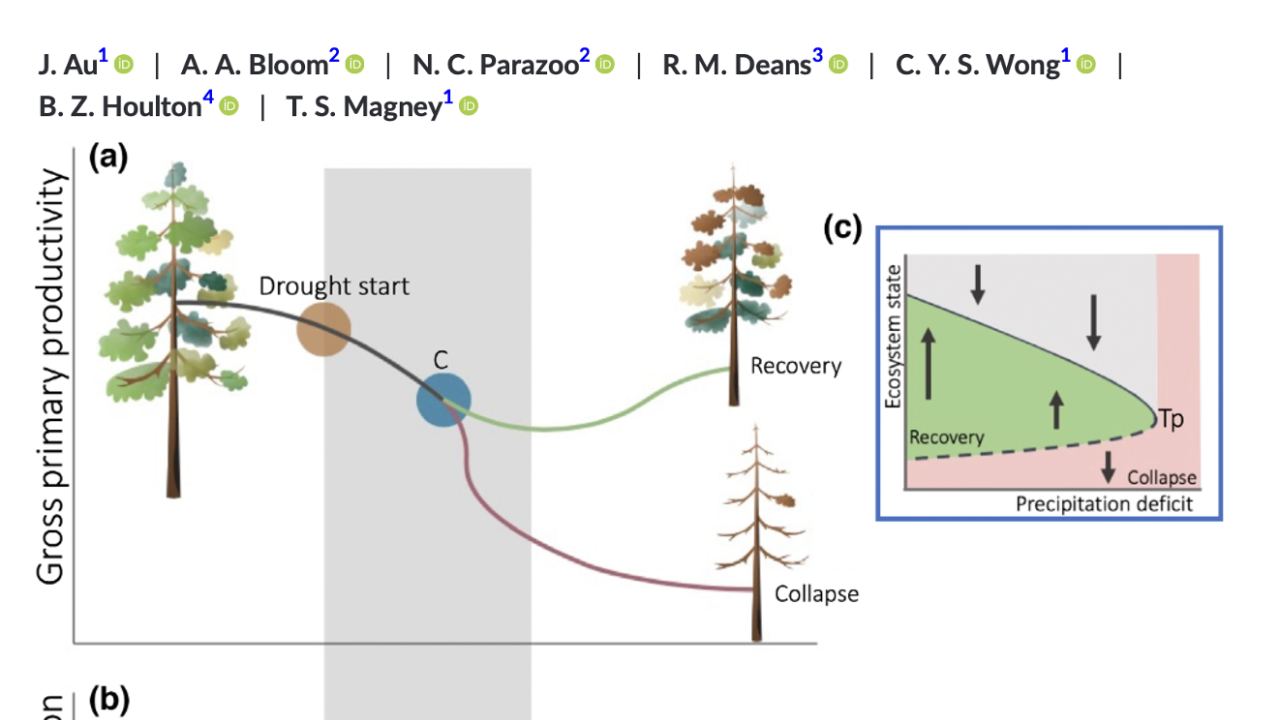
New paper on drought-induced tipping points led by Jessie Au!
How long can trees tolerate drought before the forest dies?
by Trina Kleist, August 10, 2023
Researchers from UC Davis can now predict which forests could survive despite future drought. Their new method links precipitation to tree growth, and it can help people decide where to put their resources as climate change affects patterns of snow and rainfall that impact the health of forests.
“If a forest is doing OK, but in the future we know it’s likely to get only half the average rainfall it used to get, we can calculate the likelihood it will die,” said Jessie Au, a postdoctoral scholar in the Department of Plant Sciences. She works with Troy Magney, an associate professor in the department.

Jessie Au is a postdoctoral scholar in the UC Davis Department of Plant Sciences.
The tool that Au and team developed will help anyone managing forests or using forests to store climate-warming air-borne carbon. That’s of growing interest because companies are increasingly investing in forest lands to offset their greenhouse gas emissions. Forests breathe in carbon dioxide from the air and turn the carbon into food, storing it in their trunks, roots and leaves.
But trees need water to breathe in that air-borne carbon. If they don’t get enough water, they can live off their reserves of stored carbon for a while. Like starving people living off first their fat, then consuming their own muscle, trees eventually reach a tipping point. Either rains return, and trees can recover and start making food again, or drought continues, and the forest starves to death.
Au and team discovered that tipping point by studying a forest devastated by drought in California’s southern Sierra Nevada. There, in the years following the record-shattering drought of 2012 to 2015, millions of trees died, as happened across the American West. Au’s team linked changes in precipitation during that period to life processes inside the trees, and showed the lag time between the stress of drought and trees’ response.
A paper describing this link, and the tool they adapted to measure a forest’s chances of surviving, was published recently in the journal Global Change Biology. Researchers included Chris Wong, a project scientist also with Magney’s Plant Optics Lab.
Tracking the death slide in real time
In their study, Au’s team looked at precipitation, soil moisture and temperature in the forest, and measured how much carbon dioxide the trees were breathing in. Using a new methodology, which is dubbed CARDAMOM, they linked that information to figure out how much carbon the trees were putting into their reserves, such as wood, roots and leaves, and they tracked how the reserves dwindled as the drought wore on.
When the drought started in 2012, they found trees continued to appear all right for a few years, as they lived off their reserves. However, by 2015, the trees passed a tipping point: They had used up their reserves, and 80 percent of the trees in that forest were functionally dead. They could no longer convert carbon dioxide into food.
As Au and others continue to build on CARDAMOM, it could offer even more information about what is happening inside trees during drought and other stresses, then predict how the forest will cope with future drought.
“With this new methodology, we can now link drought to tree death later on, and we can assign a number to that risk,” Au said. “It’s helping us identify vulnerable spots and whether we can save them.”
Related links
“Drought-induced tipping points for forest productivity,” Au, et al., Global Change Biology, July 2023.
-------
Technical Abstract: More frequent and severe droughts are driving increased forest mortality around the globe. We urgently need to describe and predict how drought affects forest carbon cycling and identify thresholds of environmental stress that trigger ecosystem collapse. Quantifying the effects of drought at an ecosystem level is complex because dynamic climate–plant relationships can cause rapid and/or prolonged shifts in carbon balance. We employ the CARbon DAta MOdel fraMework (CARDAMOM) to investigate legacy effects of drought on forest carbon pools and fluxes. Our Bayesian model-data fusion approach uses tower observed meteorological forcing and carbon fluxes to determine the response and sensitivity of aboveground and belowground ecological processes associated with the 2012–2015 California drought. Our study area is a mid-montane mixed conifer forest in the Southern Sierras. CARDAMOM constrained with gross primary productivity (GPP) estimates covering 2011–2017 show a ~75% reduction in GPP, compared to negligible GPP change when constrained with 2011 only. Precipitation across 2012–2015 was 45% (474 mm) lower than the historical average and drove a cascading depletion in soil moisture and carbon pools (foliar, labile, roots, and litter). Adding 157 mm during an especially stressful year (2014, annual rainfall = 293 mm) led to a smaller depletion of water and carbon pools, steering the ecosystem away from a state of GPP tipping-point collapse to recovery. We present novel process-driven insights that demonstrate the sensitivity of GPP collapse to ecosystem foliar carbon and soil moisture states—showing that the full extent of GPP response takes several years to arise. Thus, long-term changes in soil moisture and carbon pools can provide a mechanistic link between drought and forest mortality. Our study provides an example for how key precipitation threshold ranges can influence forest productivity, making them useful for monitoring and predicting forest mortality events.
Link to paper here.
Au, J., Bloom, A. A., Parazoo, N. C., Deans, R. M., Wong, C. Y. S., Houlton, B. Z., & Magney, T. S. (2023). Forest productivity recovery or collapse? Model-data integration insights on drought-induced tipping points. Global Change Biology, 00, 1–14. https://doi.org/10.1111/gcb.16867